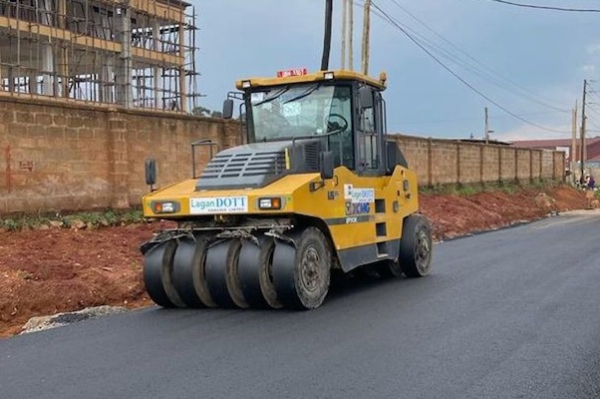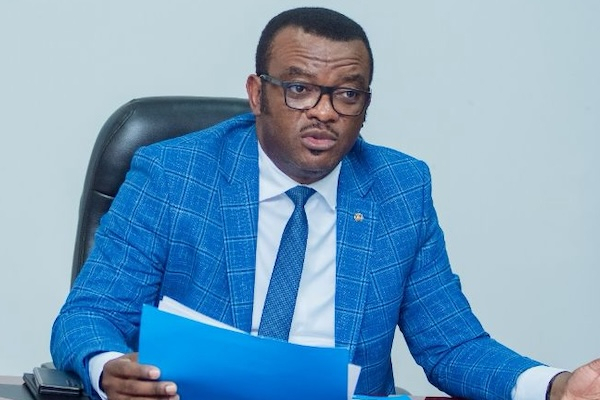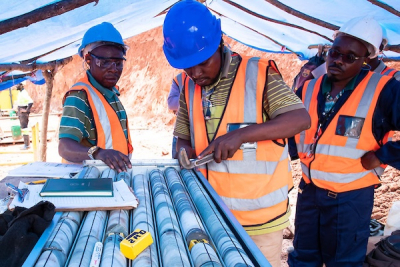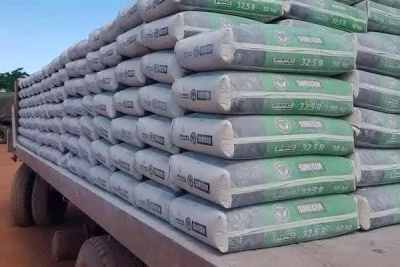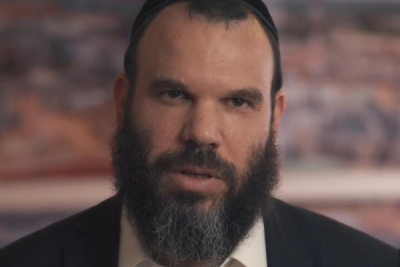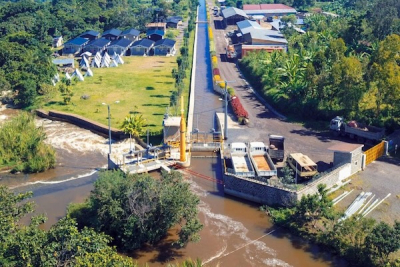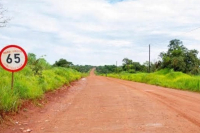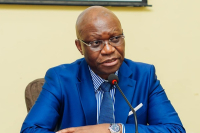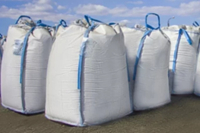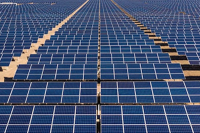
News (571)
Asphalting work on the Kasindi-Beni (80 km) and Beni-Butembo (54 km) road sections in North Kivu province will start in the first quarter of 2026. Steven Nyembo, site supervisor for Dott Services Ltd, the contracted company, made the announcement.
These construction efforts are part of a larger cross-border road project officially launched in June 2021 by the presidents of the Democratic Republic of Congo (DRC) and Uganda. The project aims to improve connectivity between the two countries, boost trade, and support peacebuilding efforts in eastern DRC. It also includes modernizing the Bunagana-Rutshuru-Goma road (89 km), bringing the total length of targeted routes to 223 km. The overall estimated cost is $551.6 million.
Dott Services Ltd is committed to financing 60% of the project, while the Congolese and Ugandan governments will each contribute 20%. The investment will be repaid through a toll system, offering reduced rates due to state contributions. The concession is set for a minimum of 15 years, with construction initially planned for three years, according to Congolese Infrastructure Minister Alexis Gisaro.
The project has faced numerous delays. Insecurity caused by M23 rebels slowed progress on the Bunagana-Rutshuru-Goma section. Work on the Kasindi-Beni-Butembo road was suspended for over a year due to non-compliance with contract clauses, particularly those related to the exemption of equipment imported from Uganda.
To overcome these obstacles, the DRC and Uganda signed an amendment to the initial agreement on October 16, 2024, which provided for tax exemptions on necessary equipment.
The project relaunched after a March 2025 visit by Uganda’s Minister of Public Works, General Edward Katumba Wamala. During his visit, authorities from both countries reaffirmed their commitment to completing the project.
Strategic Importance
The first phase of work, involving laterite on the Kasindi-Beni section, is 80% complete, according to Papy Minga, provincial director of the Roads Office in North Kivu. Preparations for asphalting are underway, with a stone crusher being installed, an asphalt plant expected, and stone quarries opened in Kilya (Ruwenzori sector) and Rugetsi.
This road is strategically important for several reasons. From a security perspective, it facilitates joint SHUJAA military operations conducted by the FARDC and the UPDF against ADF rebels. Economically, it serves as a key export route for agricultural products like coffee and cocoa to Uganda via the Kasindi border post. It also allows the import of consumer goods, including fuel, to Beni, Butembo, and surrounding areas.
As part of the relaunch, Major General Somo Kakule Evariste, the military governor of North Kivu, decided to reallocate toll revenues from these routes. Funds previously collected by road maintenance companies will now finance the rehabilitation of urban roads in Beni and Butembo, which had faced long delays due to budgetary constraints. Local sources indicate toll fees range from $2 to $20 depending on vehicle category.
Local populations eagerly await this infrastructure modernization. They see it as an opportunity to improve mobility, security, and economic development in this part of the Grand Nord.
Timothée Manoke (Intern)
The Democratic Republic of Congo is considering a partnership with commercial banks to help finance end-of-career benefits for civil servants eligible for retirement. Jean-Pierre Lihau, Minister of Public Service, Administrative Modernization, and Public Service Innovation, outlined this initiative in an information note presented during the Council of Ministers meeting on July 11, 2025.
The retirement process, which restarted in 2022 with an initial wave of 11,000 retirements, has since stalled. As a result, the number of eligible retirees has grown, now exceeding 314,000 across all pension schemes.
In response, Lihau submitted a ten-year retirement plan, from 2025 to 2035, to the Council. The proposed partnership with commercial banks is an "innovative" mechanism designed to streamline the process. The effective relaunch began with the signing of retirement orders for secretaries-general, directors, and division heads, whose payments and benefits are currently being processed.
Debt-Free Financial Structure
According to the Council’s report, this arrangement would allow banks to advance benefits to retirees. The state would then commit to repaying the banks in monthly installments equivalent to the retirees' former salaries. This mechanism leverages the existing payroll banking system and is designed to avoid any new debt issuance, making it "budget-neutral," as stated in the report.
The scheme is expected to be operational by 2026, following the signing of a memorandum of understanding between the state and the participating banks. This agreement will define the practical terms of the partnership.
An inter-institutional technical commission will oversee the implementation. This commission will include representatives from the Presidency, the Prime Minister’s Office, the Ministries of Public Service, Budget, and Finance, and the National Social Security Fund for Public Servants (CNSSAP). This body will ensure the regularity, sustainability, and automaticity of the retirement process, while balancing the number of retirements with CNSSAP’s capacity for regular pension payments.
Security Spending Constraints
In the 2025 finance law, the state pledged to allocate 20 billion Congolese francs per month, about $7 million, to fund retirements. However, according to Jean-Pierre Lihau, this commitment has not yet been met due to increased pressure on public finances from rising security expenditures. For example, between January and April, over half of the budget allocated for exceptional security spending had already been used.
The total cost of the ten-year plan, 2025 to 2035, has not yet been disclosed. However, the initial draft of the 2025 finance law included a budget line of 379.4 billion Congolese francs, about $128.4 million, for retirement benefits.
This retirement plan comes as the administration faces an overload, a consequence of a massive recruitment wave between 2017 and 2018. During that period, nearly one million employee ID numbers were issued without prior budgetary planning. This situation continues to strain public finances and human resource management. As part of a streamlining strategy, the minister plans to replace only one in two retiring civil servants.
Timothée Manoke (Intern)
Highlights:
• Loncor Gold has received a non-binding, unsolicited proposal from a third-party investor.
• A special committee has been appointed to evaluate the offer.
• The offer comes as gold prices surge, boosting investor interest in the Adumbi project.
Canadian mining firm Loncor Gold announced it has received a non-binding and unsolicited offer from an undisclosed third-party investor regarding a potential transaction. While the nature of the deal—be it an acquisition, merger, or equity stake—remains unclear, a special committee of directors has been formed to assess the proposal.
This development coincides with ongoing exploration work at the Adumbi gold deposit, Loncor’s flagship asset located in the Ngayu greenstone belt in northeastern Democratic Republic of Congo (DRC). The company controls 84.68% of the project, with 10% held by the Congolese state through its mining company Sokimo.
According to a 2021 Preliminary Economic Assessment (PEA), the site could yield approximately 303,000 ounces of gold over 10.3 years, requiring a $392 million initial investment. Loncor indicated that further updates may be released “should circumstances warrant.”
The announcement comes amid a 30% year-to-date rise in global gold prices. The metal trades above $3,000 per ounce, per World Gold Council data. The bullish market environment could help Loncor attract a strong operational partner for Adumbi.
This article was initially published in French by PM (Agence Ecofin).
Edited in English by Ola Schad Akinocho
Highlights:
• Price of a 50kg cement bag drops from 60,000 FC to 31,000–33,000 FC
• Supply disruptions caused by May–June truckers' strike now resolved
• Prices may fall further if logistics normalize
Cement prices in Kinshasa have dropped sharply in recent days, returning to near pre-crisis levels following the end of a major truckers' strike that had disrupted supply lines across the Congolese capital.
From highs of up to 60,000 Congolese Francs (CF) (≈21 USD) during the strike, a 50kg bag of cement is now selling between CF31,000 and CF33,000 (≈11 USD), down 52.4%. In some areas like Kingabwa (Limete district), prices remain slightly higher, at up to CF35,000, but further reductions are expected if supply continues uninterrupted. A bag could sell for $10 according to some predictions.
The spike in prices was triggered by a logistics paralysis due to a truckers' strike that took place between late May and early June. The strike, sparked by a provincial government ban on daytime travel for trucks over 20 tons, caused a severe shortage in cement and drove prices to record levels.
Talks between national and provincial authorities, the Congolese business federation (FEC), and transport unions led to the suspension of the strike in June, allowing deliveries to resume and easing pressure on the market.
This article was initially published in French by Ronsard Luabeya, intern
Edited in English by Ola Schad Akinocho
• Dan Gertler’s testimony details secretive payments and complex asset structures that enabled private — and often foreign — interests to control the DRC’s critical mining resources.
• Gertler admits to providing cash loans directly to the Central Bank and state companies, revealing weak financial oversight during the Kabila era.
• Despite some recent reforms, transparency and governance problems persist, hindering the DRC’s ability to maximize benefits from its vast copper and cobalt reserves.
Israeli businessman Dan Gertler’s testimony has exposed mismanagement in the Democratic Republic of Congo’s mining sector under President Joseph Kabila from 2001 to 2019. His statements are part of an April 2024 arbitration ruling in Israel, tied to a dispute with former partners Moises and Mendi Gertner. Bloomberg reported the contents on July 14, 2025, citing the NGO PPLAAF as the source.
Though Gertler denies any wrongdoing, he has faced U.S. sanctions since 2017 for allegedly amassing wealth through shady mining and oil deals in the DRC. In his testimony, he admitted to paying large sums to Kabila's close ally, Augustin Katumba Mwanke, to obtain permits—bolstering long-standing corruption allegations.
Cash Loans to BCC
Gertler’s testimony also highlights the opaque structuring of interests in gold, iron, and copper mining permits involving himself and Augustin Katumba Mwanke. Several assets were deliberately placed in separate legal entities, in accordance with their arrangements. Gertler claims he held mining stakes worth several hundred million dollars on behalf of Katumba, while remaining unaware of other Congolese stakeholders involved. This layered structure complicated oversight and enabled both private and foreign actors to indirectly influence the control of strategic Congolese mineral resources.
In addition, Gertler acknowledged providing “cash loans” to the Central Bank of Congo (BCC) and the state-run diamond company MIBA. He defended this by citing the absence of a functioning banking system at the time. Nonetheless, these transactions expose a troubling lack of oversight in financial flows within the DRC’s extractive industry.
The arbitration ruling, spanning over 1,200 pages and grounded in more than 10,000 pages of testimony and exhibits, did not aim to assess the legality of the transactions. The arbitrator found no compelling proof of corruption or illicit payments. Still, the disclosures echo long-standing criticisms of governance in the mining sector—use of front men, absence of transparency regarding beneficial owners, murky licensing processes, and informal, loosely regulated financial practices.
EITI Notes Progress
Corruption remains a serious concern in the Democratic Republic of Congo’s extractive industries. Major players like Glencore Plc have faced legal consequences, paying hundreds of millions of dollars in fines and settlements across multiple jurisdictions—including the U.S., U.K., Switzerland, and the DRC—for corrupt practices linked to mining asset acquisitions.
Dan Gertler’s involvement continues to attract scrutiny. Despite agreeing in 2022 to surrender some assets, recent tax proceedings confirm that he still benefits from royalty rights in three large-scale copper and cobalt projects. His ongoing presence highlights the persistence of opaque financial arrangements in the sector.
The DRC has made incremental progress. EITI’s 2024 report notes the country's commitment to beneficial ownership transparency, with public disclosures dating back to 2015—though data gaps remain. The 2018 mining code mandates the publication of contracts and permits, but implementation remains inconsistent. The IMF, in its January 2025 report, acknowledged advances in reform, while urging the DRC to strengthen enforcement and reduce loopholes—particularly the 25% threshold for beneficial ownership, which remains too permissive.
Economic Stakes
Further governance concerns arise from the government's recent decision to require oil exports to use officially approved charterers. While intended to improve control over export logistics, this raises new questions about the accountability and transparency of intermediaries.
The Democratic Republic of Congo relies heavily on its mining sector, making transparency vital for economic growth. In 2024, the country produced 3.3 million metric tonnes of copper—a 12.6% year-on-year increase—ranking it second globally. It remains the world’s top cobalt producer, with 170,000 tonnes extracted and reserves estimated at 6 million tonnes.
Mining accounts for roughly 6% of national GDP and provides 40% of government income. Stronger governance would help the DRC maximize revenues, attract responsible investors, improve wealth distribution, and meet international expectations for ethical supply chains of key minerals like copper and cobalt.
This article was initially published in French by Georges Auréole Bamba
Edited in English by Ange Jason Quenum
• Virunga Energies increases power capacity to 42 MW with new turbine.
• The company serves over 35,000 customers across North Kivu.
• Rwanguba project plays key role in reducing energy shortages in Goma.
Virunga Energies has ramped up electricity production in North Kivu, Democratic Republic of Congo, despite ongoing insecurity in the region. The company, owned by Virunga National Park, has launched the first turbine of its Rwanguba hydroelectric plant, adding 13 megawatts (MW) to its grid.
This upgrade brings the company’s total output to 42 MW. Virunga Energies aims to hit 100 MW by 2040. Rwanguba now joins three other plants in the network: Mutwanga (1.4 MW), Matebe (13.1 MW), and Luviro (14.6 MW), each located in different parts of the province.
Virunga Energies has become North Kivu’s largest power producer and distributor. It currently supplies electricity to more than 35,000 customers, including 2,000 businesses.
According to the company’s 2023 annual report, the full Rwanguba project — combining turbines Rwanguba 1 and 2 — will generate up to 26 MW when completed. While the report did not specify the commissioning date for Rwanguba 1, it projected completion between late 2024 and early 2025.
A source inside the company confirmed that engineers accelerated the turbine launch to address severe power shortages in Goma. During the dry season, low water levels in the Rutshuru River disrupted operations at the Matebe plant, prompting the urgent activation of Rwanguba. The new turbine has helped stabilize electricity supply across the city.
In 2023, electricity sales brought in $10.7 million in revenue. Part of the power generated supports cryptocurrency mining, the report noted.
Virunga Energies has not disclosed the total cost of the Rwanguba 1 and 2 project. However, the European Union injected €20 million into the project in June 2016 to support its development.
The Rwanguba site suffered a major security incident on August 16, 2022. Heavy artillery, allegedly fired by M23 forces positioned less than 5 km away, hit the facility. Two shells struck the site, causing severe material damage. No workers were killed, thanks to a rapid evacuation. But civilian casualties were reported in surrounding villages.
In a recent move to strengthen regional cooperation, Virunga Energies struck a deal with Énergies du Nord-Kivu (ENK), which holds exclusive rights to distribute power in Beni and Butembo. Following talks with North Kivu’s military governor, General Evariste Kakule Somo, both companies agreed to pool their resources.
The agreement will allow Virunga Energies to use ENK’s infrastructure to distribute electricity in Beni and Butembo — two of North Kivu’s largest cities.
This article was initially published in French by Timothée Manoke, Intern
Edited in English by Ange Jason Quenum
Congolese authorities have begun construction on the 160-kilometer Likasi-Solwezi road, a project expected to significantly boost trade between the Democratic Republic of Congo (DRC) and Zambia. Haut-Katanga Governor Jacques Kyabula announced the launch of the $230 million project on July 8, 2025, during a visit to Likasi, the province's second largest city. The road is expected to take three years to complete.
According to Okapi Global Engineering Consultations LLC, the project also includes building three toll stations and a dry port in Kikoyo Mwabesa with a capacity for 1,000 vehicles.
Leveling work is already underway and well advanced in certain sections, particularly near the Panda bridge at the entrance to Likasi. Radio Okapi reported a large fleet of equipment, including dump trucks, water tankers, graders, and compactors, mobilized at the site in preparation for paving.
Vaste Réseau des Services au Congo (VRSC) is carrying out the work. The terms of its selection have not been publicly disclosed, but it is described as a company specializing in civil engineering and logistics, providing solutions to mining firms.
Under development for several years, this road is expected to play a strategic role in boosting trade between the DRC and Zambia. It will help ease congestion on the heavily used Likasi-Lubumbashi-Kasumbalesa axis, thereby improving traffic flow in this mining zone.
In parallel, other links between the DRC and Zambia are under construction, such as the Kolwezi-Solwezi road corridor. This approximately 165-kilometer corridor aims to directly connect two mining regions to stimulate trade, decongest existing roads, and strengthen economic integration between the two countries.
Ronsard Luabeya (Intern)
The Democratic Republic of Congo will introduce a 2% tax on imported goods to fund its universal healthcare program. Food and agricultural products will be exempt. Health Minister Roger Kamba announced the measure on July 14 and said Prime Minister Judith Suminwa is expected to sign the decree this week.
The tax aims to provide steady funding for the country’s under-resourced healthcare system, which has faced repeated budget shortfalls due to competing security priorities, especially in eastern DRC. Revenues will go directly to the national Health Promotion Fund, which manages drug procurement, hospital renovations, and equipment upgrades nationwide.
Minister Kamba said the new tax is a structural response to the unstable and often insufficient budget support from the national treasury. In addition to the import levy, a second funding mechanism was recently approved by the National Labor Council, which includes unions, employers, and the government. It introduces a 2.5% health contribution based on gross salary—0.5% paid by workers and 2% by employers. For those earning the recently raised minimum wage of $130, this equates to a monthly contribution of $3 by employees and $13 by employers.
The minister said both measures will help ensure long-term financing for the country’s universal health coverage (UHC) goals. The current program, launched in September 2023, offers free childbirth services in public hospitals. Future expansion is expected to cover more services as funding grows. The UHC initiative is part of a national plan to make healthcare a guaranteed right for all Congolese citizens.
Ronsard Luabeya, intern
• CMOC increased DRC cobalt production to 61,073 tonnes in the first half of 2025, up 13% year-on-year.
• Cobalt exports remain frozen under a government embargo, while copper prices hit record highs.
• Cobalt prices jumped 60% after the embargo but CMOC cannot ship, forcing a stockpile build-up.
China’s CMOC group ramped up cobalt output in the Democratic Republic of Congo (DRC) to 61,073 tonnes in the first half of 2025, a 13% rise over last year. The company shared these results in a financial report on July 14. Production surged 20% in the first quarter, as CMOC mined a total of 30,414 tonnes from its Tenke-Fungurume and Kisanfu sites.
CMOC credited higher mineral prices for the production jump. Cobalt is a by-product of copper, and surging copper prices have driven the mining boom.
Yet the landscape for cobalt is difficult. Since February 24, CMOC has not exported cobalt after the Congolese government imposed an embargo to support prices as the market faces oversupply. On June 30, CMOC halted all cobalt deliveries. Its trading subsidiary, IXM, declared force majeure on cobalt contracts in response to the disruption.
After the embargo started, cobalt prices soared by 60%, hitting a peak of $33,700 per tonne in April. While prices dropped in June, they rebounded following a DRC decision to extend the export ban. Cobalt is still trading above $33,700 per tonne.
CMOC says it still targets annual cobalt production between 100,000 and 120,000 tonnes in 2025. However, the path to resuming exports remains unclear. The export embargo technically ends in September, but the Regulatory Authority for Strategic Mineral Substances Markets (ARECOMS) has warned it might extend, modify, or lift the ban at any time. The agency has not announced a target price for lifting the restriction. The DRC state budget for 2025 is based on a cobalt price of $28,000 per tonne.
Pierre Mukoko with Agence Ecofin
CrossBoundary Energy (CBE), a developer of distributed renewable energy solutions, announced on July 14, 2025, it secured a $60 million loan from Standard Bank South Africa. The financing will accelerate the development of a solar power plant designed to supply the Kamoa-Kakula copper complex in the Democratic Republic of Congo (DRC).
This funding will expedite the procurement of critical long-lead equipment. This includes battery energy storage systems (BESS), photovoltaic solar modules, and substations, aiming to reduce the commissioning time for the 223 megawatt-peak (MWp) plant. The plant will be coupled with a 526 megawatt-hour (MWh) storage system and ensure a stable 30 megawatt (MW) power supply to the mine.
Beyond equipment procurement, initial construction began in the second quarter of 2025 with geotechnical studies and site clearing. Completion is scheduled for mid-2026.
The plant, owned by CrossBoundary Energy, will supply electricity to the mining complex for 17 years under a power purchase agreement (PPA) signed with Kamoa Copper.
Located in Lualaba Province, Kamoa-Kakula is one of Africa’s most advanced copper projects. Its expanding operations require a continuous electricity supply. The site's power needs are expected to reach around 240 MW when phases 1, 2, and 3, along with the future smelter, are all running at full capacity by 2026. The solar-plus-storage project is a key initiative to secure a stable and decarbonized energy supply for the complex.
PM
More...
Kamoa Copper, owner of the Kamoa-Kakula copper complex, signed a sales contract with Swiss trader Trafigura to sell 20% of the copper anode output from its smelter. The smelter will begin operations in September 2025. Ivanhoe Mines, a major shareholder in Kamoa Copper, revealed this in its quarterly report on July 8.
The deal, finalized in June, spans three years. Trafigura also provided a $200 million advance loan to Kamoa Copper. The loan carries an interest rate based on the US dollar’s average monthly SOFR rate plus 3.75%. Kamoa Copper will repay this advance with copper anodes equal to the loan amount plus interest.
With this contract, Kamoa Copper secures pre-sales for 100% of its smelter’s production, which is expected to reach 500,000 tonnes of copper anodes per year. Earlier in January, Ivanhoe Mines announced agreements covering 80% of smelter output with Chinese firms CITIC Metal and Gold Mountains International Mining Company, affiliates of Zijin Mining. Zijin Mining also holds stakes in Kamoa Copper and Ivanhoe Mines. That deal included a $500 million advance loan on terms similar to Trafigura’s.
Since starting production in mid-2021, Kamoa Copper has favored pre-sale agreements backed by advance payments. However, the Congolese government, holding a 20% minority stake, has expressed concerns. Alongside Ivanhoe Mines (39.6%), Zijin Mining (39.6%), and Crystal River Global Limited (0.8%), Kamoa Copper operates under Kamoa Holding Limited.
Ivanhoe Mines insists these contracts reflect “competitive and independent commercial terms.” Yet, in December, Congo’s Portfolio Minister Jean-Lucien Bussa criticized Kamoa Copper for selling below market prices. He announced plans for the government to participate in selecting buyers to optimize copper revenues and ensure fair resource valuation. No recent updates have emerged on implementing this measure.
This article was initially published in French by Pierre Mukoko
Edited in English by Ange Jason Quenum
U.S. President Donald Trump announced on July 8 a 50% tariff on all copper imports, a move intended to repatriate copper production and reduce foreign dependence, which he described as a national security risk.
The United States ranks as the world’s second-largest copper importer after China. It mainly imports refined copper. According to the U.S. Department of Commerce, copper imports hit $17 billion in 2024, with $6 billion coming from Chile alone.
The administration has not confirmed an official start date for the tariff but hinted it could take effect as early as August. The announcement immediately sent copper prices soaring on the U.S. market. On the Commodity Exchange (COMEX), futures contracts jumped 13%, marking the largest single-day gain since 1968. Prices then settled just below $5.60 per pound the next day.
Traders reacted to the prospect of costlier copper imports by anticipating shortages. Some signs point to speculative buying, as investors seek to profit from expected price hikes once the tariffs kick in.
Ripple Effects on the DRC
This price surge comes amid strong global demand for copper, a metal essential for electric vehicles (about 80 kg per car), renewable energy, and infrastructure projects. Analysts project a global supply shortfall of 4.5 million tonnes by 2030. This deficit supports prices on international markets, including the London Metal Exchange (LME). Meanwhile, Trump’s push to curb Chinese influence in supply chains adds to trade tensions.
The Democratic Republic of Congo produced roughly 2.5 million tonnes of copper in 2024, about 11% of the world’s supply. The country stands to benefit indirectly from rising prices. Major foreign companies such as CMOC, Zijin Mining, Ivanhoe Mines, and Glencore dominate Congolese copper production. The state usually holds only a minority stake.
Most copper production in the DRC sells through forward contracts, often with entities linked to producers. These agreements fix prices in advance or use past averages, limiting the government’s ability to immediately profit from price spikes. In contrast, mining companies see their stock values rise directly. The Congolese government has expressed interest in joining marketing processes but has made little concrete progress so far.
On the fiscal front, the DRC collects export royalties. However, these taxes often rely on anticipated average prices, which means the government misses out on sudden price jumps.
Medium-Term Prospects
The 2018 Mining Code’s superprofit tax could become a key tool. This 50% tax applies when commodity prices exceed by 25% the economic assumptions in feasibility studies. For example, if a study assumes $4 per pound ($8,818.5 per tonne), the tax applies from $5 per pound ($11,023 per tonne). With U.S. copper prices currently at $5.60 per pound ($12,368 per tonne), this tax is now relevant.
Copper prices rose 38.8% between January and July 2025, from $4.04 to $5.61 per pound, and nearly doubled over five years. Many projects now exceed the superprofit tax threshold. However, estimating the exact fiscal gain remains challenging.
The long-term impact of the U.S. tariff on the DRC depends on how it influences prices and demand. Analysts agree U.S. copper imports will not drop immediately despite the tariffs. The U.S. lacks the mines, smelters, and refineries to meet its needs alone. Projects like Resolution Copper require 7 to 10 years and billions in investment to come online.
The U.S. imports about 45% of its copper needs. Washington may even increase copper purchases to support its reindustrialization plans. Global demand should grow 3 to 5% annually through 2030, driven by the energy transition.
If the DRC boosts production to 3.5 to 4 million tonnes, as planned with expansions like Kamoa-Kakula, the country could earn $30 to $40 billion annually in export revenues by then.
Georges Auréole Bamba
On July 8 in Abu Dhabi, UAE-based investment group NG9 Holding signed two confidentiality agreements with Congolese companies Buenassa Resources SA and Kipay Energy. The deals were signed in the presence of Daniel Mukoko Samba, the Democratic Republic of Congo’s Minister of National Economy. The non-disclosure agreements open the door for formal discussions toward future partnerships.
NG9 Holding is a diversified conglomerate based in Abu Dhabi, formed by the merger of Nirvana Holding, Gewan Holding, and 9Yards Group. It operates across tourism, hospitality, logistics, and media sectors.
According to the Ministry of Economy, as reported by Radio Okapi, NG9 Holding could play a key role in financing the two Congolese projects thanks to its $500 million energy fund and credit lines that could extend beyond $1 billion.
Buenassa Resources is leading the development of DR Congo’s first integrated copper and cobalt refinery. A completed feasibility study pegs the cost of the project’s first phase at $600 million. By the end of 2027, the plant is expected to begin operations with an annual output of 30,000 tons of copper cathodes and 5,000 tons of cobalt sulfate. The long-term goal is to scale up to 120,000 tons of copper and 20,000 tons of cobalt per year.
Kipay Energy is spearheading the Sombwe hydropower project in Haut-Katanga. The facility will combine a hydroelectric station with a 46 MW solar component, for a total capacity of 166 MW and an estimated annual output of 967 GWh. The $500 million investment aims to reduce the province’s energy deficit by 10%, power 100,000 homes, support the production of 300,000 tons of copper, and create 4,000 direct and indirect jobs.
U.S firm Anzana Electric Group (AEG) has given its preliminary agreement to join the regional Ruzizi III hydropower project, following an invitation from Ruzizi III Holding Power Company Limited (RHPCL). The two parties signed an invitation agreement on June 24, 2025, during the U.S.-Africa Business Summit in Luanda. They committed to finalizing a legally binding partnership by September 15, 2025, according to a joint statement.
The forthcoming agreement will define governance rights, investment commitments, and long-term collaboration prospects. The statement also indicates that AEG could acquire at least 10% of RHPCL’s capital. This reflects a desire for Anzana to be not just an investor but also a stakeholder involved in the project’s strategic direction.
The Ruzizi III project, with an estimated cost of $760 million, involves constructing a 206 MW hydropower plant on the Ruzizi River, located between the Democratic Republic of Congo (DRC) and Rwanda. It is a public-private partnership bringing together RHPCL and the governments of the DRC, Rwanda, and Burundi. Each state holds a 10% stake in the project company, Ruzizi III Energy Limited (REL), while RHPCL is the majority shareholder with 70%.
RHPCL's current shareholders are SN Power, a subsidiary of TotalEnergies, and Industrial Promotion Services (IPS), an entity of the Aga Khan Group. RHPCL's board members consider AEG's entry "strategic" due to the American company's expertise and experience. Anzana Electric Group is already active in Africa, particularly in Burundi, where it operates the Weza Power distribution project and two hydroelectric plants run by Songa Energy, with a combined capacity of 10.65 MW.
According to Africa Intelligence, the United States is actively supporting an American company's entry into Ruzizi III. Washington backed the project during the negotiation of the peace agreement signed on June 27, 2025, between the DRC and Rwanda, considering it among the confidence-building measures. This support could reassure certain donors whose commitments depend on the security situation in eastern DRC.
The Walungu territory in South Kivu, where the plant is to be built, is currently experiencing clashes between the Congolese Armed Forces and M23 rebels. This unstable context poses a direct threat to the project's implementation. Its financial close is expected by September 30, 2025.
Pierre Mukoko & Timothée Manoke






